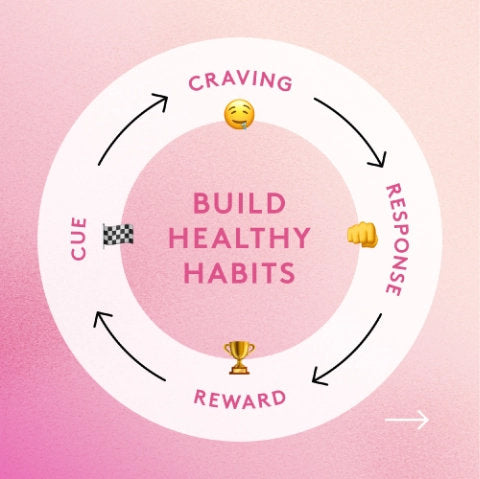Building a strong, wide back is a huge must if you're looking to round out your physique. While hitting the lat pulldowns and T-bar rows may give you wings, it's not just about appearance.
A strong back is also critical for twisting the torso, pulling your arms down from above your head, and, perhaps most importantly, stabilizing the spine. It's also essential for increasing movement efficiency, especially with pulling and twisting movements.
What's more, if you want to improve big compound movements like the deadlift and bench press, a strong back will help that, too.
A bigger back is the foundation of a bigger upper body, so we're giving you a rundown of the 7 best back exercises for thickness. Let’s get to it!
Key Takeaways
The top 7 thickness back exercises are:
- Deadlifts: A powerhouse move that not only sculpts your legs and glutes but massively strengthens your back, offering intense full-body muscle and strength gains, from quads to abdominals, by allowing heavy loads for ultimate growth.
- Pull-ups: The ultimate thick back builder with a simple setup, challenging your lats, biceps, and core by pulling your body weight, enhancing strength, and engaging stabilizer muscles with minimal equipment needed.
- Bent-over Rows: Flex those arms and back muscles with dynamic equipment choices—dumbbells to barbells—perfecting posture and powering through the posterior chain for unmatched upper back strength and size.
- Chest-Supported Rows: Zero in on back strength with precise muscle engagement. This is one of the rowing exercises that's a safer alternative for those with lower back concerns, ensuring focused growth for lats, traps, and rhomboids with reduced injury risk.
- Lat Pulldowns: Build shoulder width and that desirable V-shape with continuous tension for peak back muscle engagement, a perfect prep step for conquering pull-ups, targeting everything from your upper back to your forearms.
- Neutral Grip Pulldowns: Elevate your back and bicep training with a V-attachment for a chin-up feel, ensuring constant cable tension for balanced muscle activation and a focused attack on the lats and biceps.
- Seated Cable Rows: Customize your back blast with grip variations—target lats or upper back muscles with precision, leveraging constant cable resistance for deep, even muscle engagement and robust strength gains.
We'll cover each of these exercises in greater detail, as well as sharing some example training routines that feature them, later in this article.
Back Anatomy
Before we dive into the best exercises to increase back thickness, strength and size, it's crucial that you actually understand how the back works and what muscles you need to be hitting to put on mass.
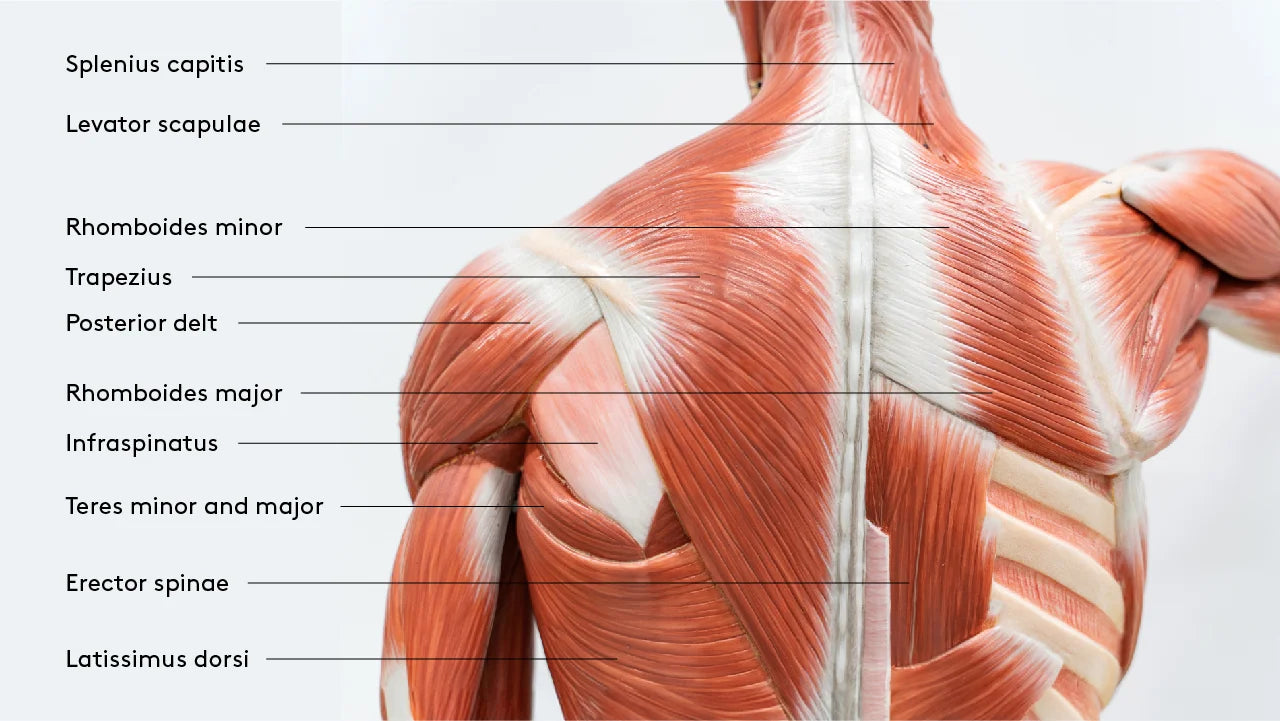
The back is one of the biggest muscle groups and isn't just composed of the lats, but also the lower back, the upper and lower traps, rear delts, and several smaller stabilizer muscles. It's generally classified into three groups.1,2
-
Intrinsic or deep muscles: Muscles that attach to the vertebral column and are responsible for the movement of the axial skeleton; they assist with flexion/extension, side bending, and rotation
-
Superficial muscles: Muscles that assist with shoulder and neck movement, along with the movement of the limbs
-
Intermediate muscles: Muscles that help with the movement of the thoracic cage
Each of these categories houses its own muscles, and if you want to build back thickness, you need to be hitting all the major muscles. These include:
- Trapezius
- Latissimus dorsi
- Levator scapulae
- Rhomboids
- Posterior (rear) delt
- Teres major and minor
- Infraspinatus
- Erector spinae
So, if you're looking to test the limits of your t-shirts, we're outlining the best exercises for thicker back that hit each of the muscles above.
Whether you're a beginner or a novice lifter, get ready to earn size that will show up from every angle.
Top 7 Exercises To Build A Bigger Back
1. Deadlift
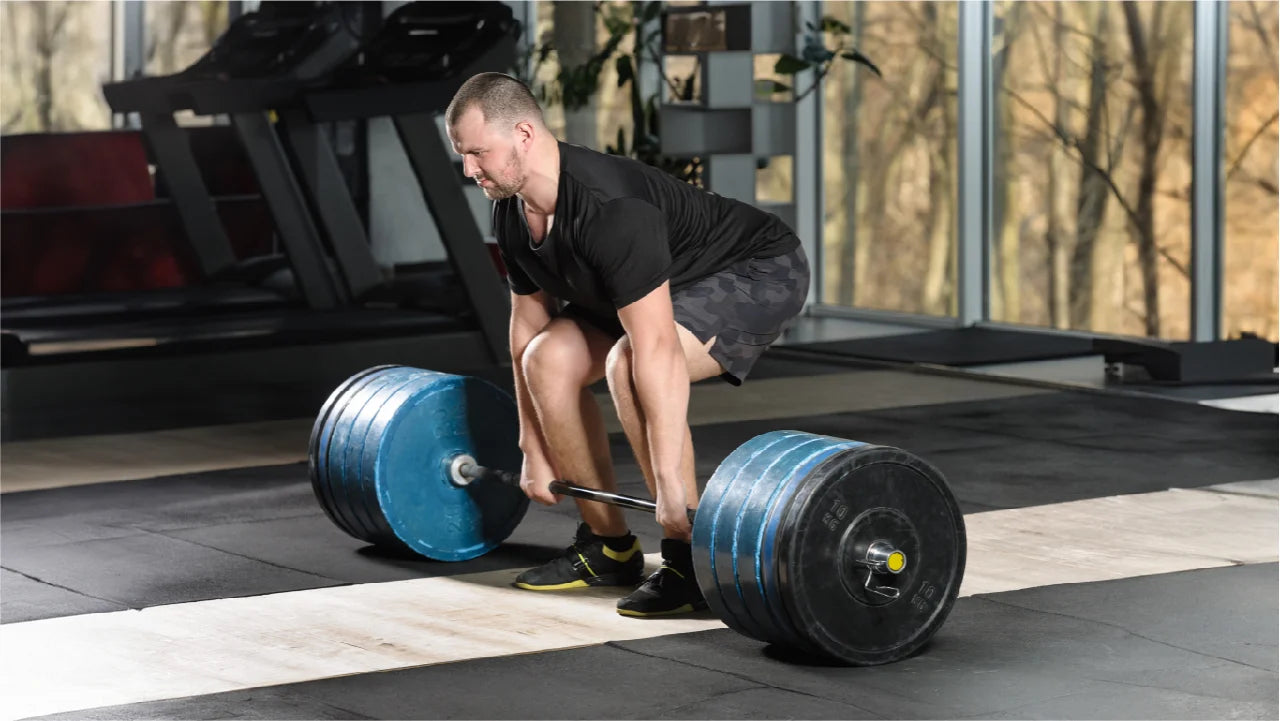
You may be thinking that deadlifts are for the legs and glutes, but it is also great for back thickness. Start with your feet shoulder width apart to ensure stability and proper form.
It’s actually one of the best compound movements for gaining size and strength in the back, along with the hips and hamstrings.
Because deadlifts can often be trained with higher volumes and heavier loads than most exercises, it offers a fantastic stimulus for increasing back width.
And while the back muscles don’t directly contribute to the deadlift movement and range of motion, they’re essential for keeping the spine stable and safe while supporting the heavy loads required for growth.
Here’s why you should deadlift:
- Activates back muscles along with the hamstrings, glutes, and the muscles in the hips
- You can load up the barbell with heavy weight for major strength gains
- Use high loads or volume to produce muscle and strength gains in both the upper and lower body
Muscles worked: Quads, glutes, inner thigh, hamstrings, spinal erectors, lats, traps, rhomboids, abdominals, obliques
2. Pull-Up

Most people underestimate the effectiveness of a pull-up for building a solid back because it's a bodyweight exercise.
And although the execution is relatively simple, it can take a fair bit of practice to nail proper form to target the back muscles effectively.
Weight can be added to a pull-up using a weight belt, but pulling your bodyweight up creates instability that engages the core muscles to maintain stability.
Plus, the more you weigh, the more weight you have to pull, which increases the stimulus for strength adaptations.
Here's why you should consider pull-ups as a go-to exercise for building back thickness:
- Virtually no equipment required—you just need to grab the bar, pull up, slowly lower yourself and repeat for your desired number of reps.
- Needing to stabilize your body weight recruits the smaller stabilizer muscles plus the muscles in the core
Muscles worked: Lats, biceps, infraspinatus, lower traps, erector spinae, external oblique
3. Bent-over Row
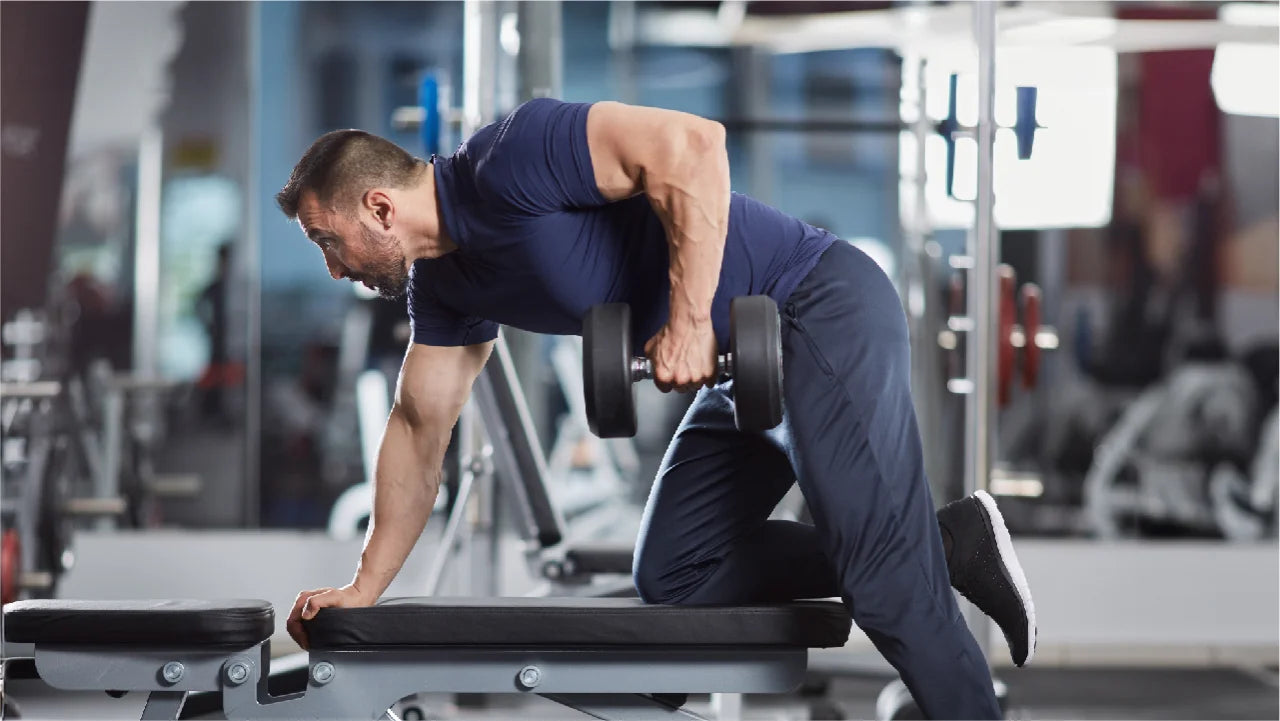
There's a lot of variation that can be done with the bent-over row, but whether you use kettlebells, dumbbells, or a barbell, it's nonetheless an excellent exercise for building a thick back.
When hinging at the hips, lean forward and bring the weight up to stomach level to really engage the entire posterior chain. Keep increasing weight as you progress.
Here's why you should do bent-over rows:
- Better upper back hypertrophy and strength
- Can be performed with a variety of equipment (DBs, KBs, barbells)
- Great for overloading muscles with greater weight stimulus
Muscles worked: Lats, spinal erectors, hamstrings, scapular stabilizers
4. Chest-Supported Row

This exercise is, of course, a variation on the classic bent-over row that takes momentum out of the equation.
When you aren't able to move your body, you can really focus on contracting the muscles in the back as you move the weight.
It's also a great variation for people with lower back issues because the lower back muscles aren't as engaged as they would be in a traditional hinge position.
Here's why you should do chest-supported rows:
- Isolates the back muscles to increase activation and subsequent strength gains
- Reduces pressure and strain on the lower back for greater support and less risk of injury, including for those with range of motion issues
Muscles worked: Lats, traps, rhomboids, biceps
5. Lat Pulldown
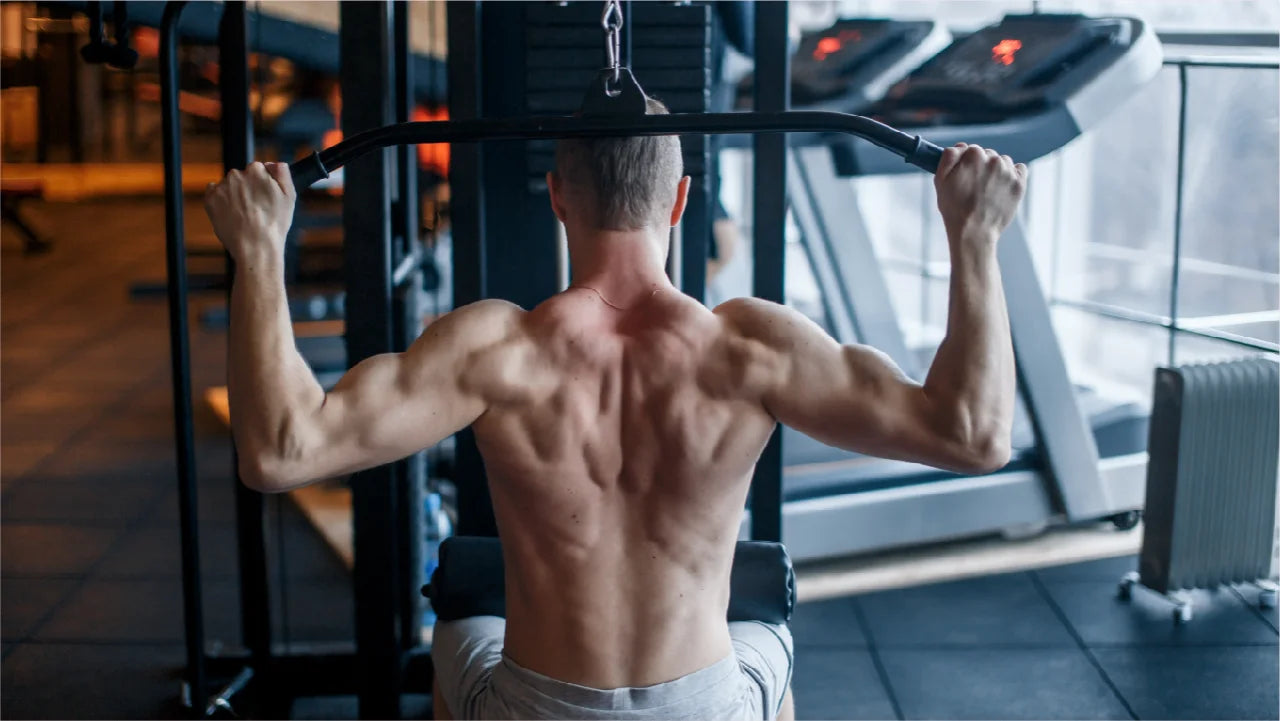
The lat pulldown is a classic back exercise that's super effective for building those wings or getting that V-shape.
The constant tension on the machine cable increases time under tension for greater stimulation and more significant muscle growth.
As well, for those who can't yet do a pull-up, this is a great alternative. It's essentially the same movement, but you're not pulling your entire body weight.
Here's why you should do lat pulldowns:
- Great for back training, constant tension fully engages the back muscles
- Movement mimics a pull-up, so it's great for working your way up to complete a full pull-up
- Pronated grip targets muscles of the upper back, biceps, and lats
Muscles worked: Lats, teres major, delts, traps, rhomboids, levator scap, biceps, brachialis/brachioradialis (forearms), triceps, rotator cuff
6. Neutral Grip Pulldown

This movement is similar to a lat pulldown, except you're using the V-attachment with a neutral grip (palms facing each other) from your starting position and then pulling down towards your chest.
It's another cable exercise that allows you to take advantage of the constant tension on the cable that can, again, increase time under tension.
Unlike the classic lat pulldown, the neutral grip variation allows you to isolate muscles like the lats and biceps.
Here's why you should do neutral grip pulldowns:
- Constant tension of the cables creates even tension on the back muscles for greater and more even activation
- Mimics a chin-up action, so it's great for people who can't yet do a chin-up
- Neutral grip targets the lats and biceps more effectively
Muscles worked: Lats, rhomboids, teres major, teres minor, infraspinatus, rear delts, biceps
7. Seated Cable Row (Lats + Upper Back)

There's two ways to do the seated cable row that target either the lats or the muscles of the upper back—shoulder width neutral grip attachment or a row attachment; the starting position of your arms will dictate which muscles are hit.
Like the pulldown, the cable allows you to take advantage of constant resistance, the hand position, and arm path, all of which create greater tension on the lats to build strength and size.
In the row attachment variation, the arm path is higher than the seated row focusing on lats, which allows you to effectively target the muscles of the rear delts and upper back (traps, rhomboids, teres major).
Here's why you should do seated cable rows:
- Constant tension of the cable creates greater and more even resistance across the back muscles
- Seated variation increases muscle and strength in the upper and mid-back
- Neutral grip allows for effective targeting of the lats and biceps (lat-focused row)
- Higher arm path and semi-pronated grip effectively targets muscles of the rear delts and upper back (upper back row)
Muscles worked: Lats, rhomboids, rear delts, traps, teres major, biceps
Tip: Don't forget to warm up! Range of motion exercises to give your back a good stretch will help you build thick body composition with less risk of back injury.
Back Workout for Thickness: Two Options
Need some step by step inspiration? Here are two solid workouts featuring back thickness exercises that'll set your muscles on fire.
Workout #1:
- Wide grip pull-ups: 5 sets, 12, 10, 8, 6, 4 reps
- Bent-over barbell row: 3-5 sets, 8-10 reps
- Neutral grip lat pulldown: 4 sets, 10-12 reps
- Seated cable row: 4 sets, 10-12 reps
- Incline DB row: 3 sets, 8-12 reps (triple dropset on final set)
Workout #2:
- Bent over DB row: 3 sets, 8-12 reps
- Chest-supported row: 3 sets, 10-12 reps
- Wide grip lat pulldown: 4 sets, 10-12 reps
- Deadlift: 4 sets, 6-8 reps (heavy)
- Back extension: 3 sets, 8 reps (optional use of weighted plate)
Tips For Building A Better Back

Because the back comprises a number of large muscle groups along with several smaller muscles, it can be really easy to do an entire back thickness workout and not really feel like you’ve hit it at all.
Unless you’re training with impeccable form and using the right weights, you could be underworking your muscles and aren’t going to see the progress and growth you want.
So, if you’re someone who enjoys the pain of an intense back workout, here are some tips for getting the most out of your back thickness training sessions.
- Watch your grip: If you squeeze the bar or handle too hard, you’re taking away from the back muscles and engaging the forearms and biceps too much, which means you’re not hitting the back muscles like you could be. You want a firm grip, but not so hard that your arms are taking over. If you struggle to hold the bar properly, try lifting straps.
- Hold the pause: At the top of each rep, when the shoulder blades are pinched together or retracted, pause for 1-2 seconds. Pause again for 1-2 seconds once the movement is released, and the muscles are in the stretched position.
- Choose your weight wisely: Most people compromise form for weight. Choose an appropriate weight that allows you to have complete control over the entire movement so you can really feel each rep working your back muscles. Using too much weight means you won’t actually feel the correct muscles working.
- Maintain a feet shoulder width stance: Maintain a feet shoulder width stance for exercises like deadlifts and barbell shrugs to ensure stability and proper form.
- Stabilize well: Creating tension in the upper back is critical when setting up an exercise to stabilize the upper body during back exercises. Stability helps to increase force production and leads to better performance and more quality training volume.
- Train the full range: If you want to reap the full benefits of a back workout, you need to contract the full muscle by moving from your starting position through the full range of motion. It’s poor technique to stop short of the full ROM, but it also compromises your gains.
Conclusion
Building a thick, powerful back requires a strategic blend of exercises that target both the breadth and depth of the back muscles.
From the foundational deadlifts that engage multiple muscle groups to the precision of chest-supported and seated cable rows, each exercise plays a pivotal role in sculpting a dense and muscular back.
Incorporating a variety of movements, such as pull-ups for upper body endurance, bent-over rows for mid-back thickness, and lat pulldowns for that coveted V-shape, ensures comprehensive development.
By focusing on constant tension, proper form, and progressive overload, you can maximize muscle growth and achieve a back that's not only aesthetically impressive but functionally strong.
Remember, consistency in your training regimen, coupled with adequate nutrition and rest, is key to unlocking your back's full potential.









